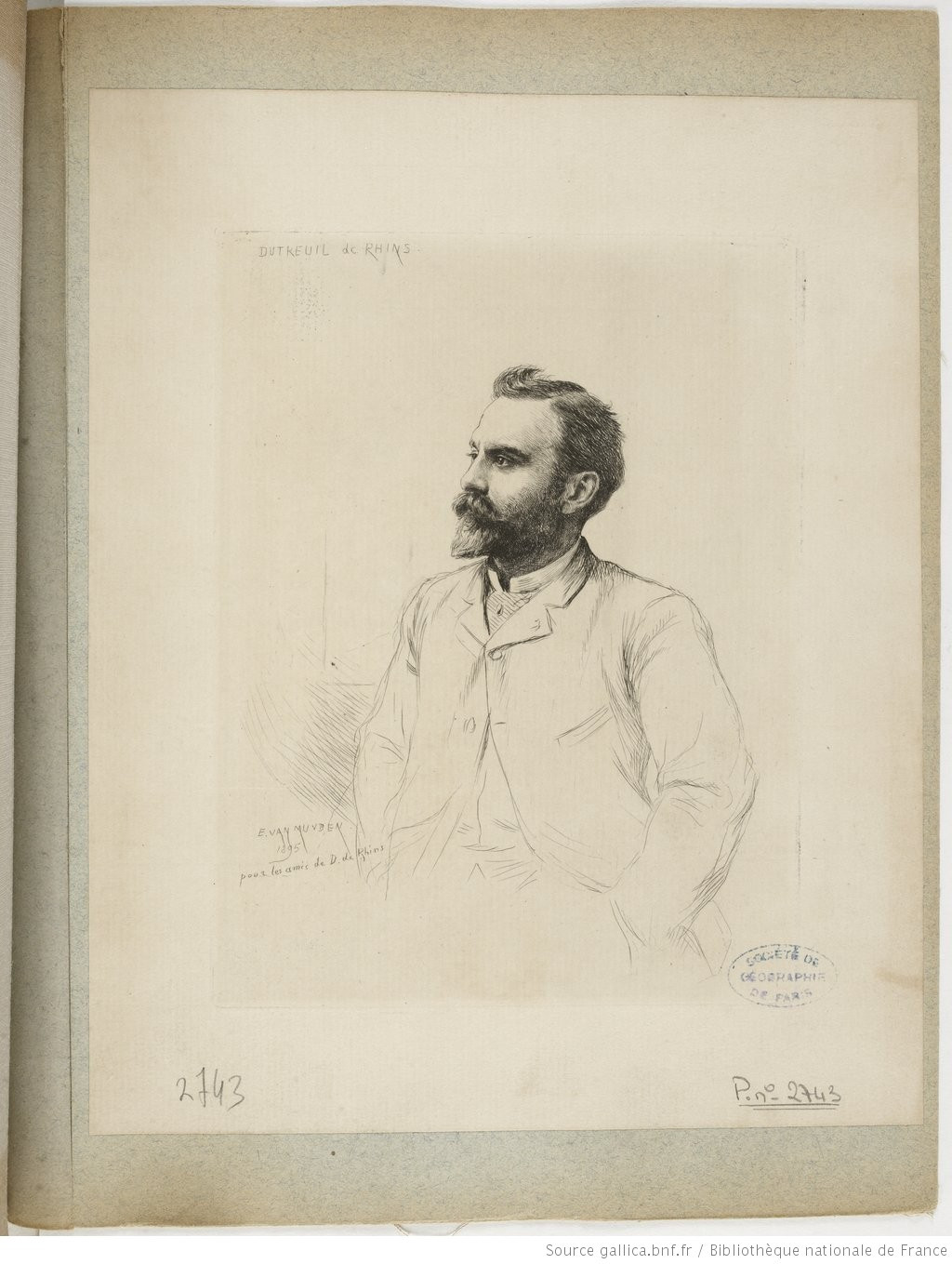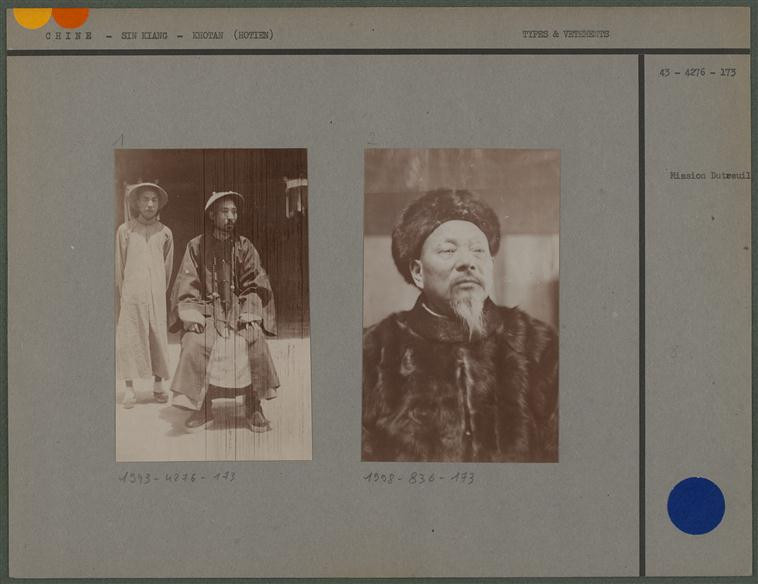
DUTREUIL de RHINS Jules-Léon (EN)
Biographical Article
Jules-Léon Dutreuil de Rhins was born in Saint-Étienne on January 2, 1846, into an aristocratic family. One of his family members founded the Charité hospital in Lyon and another, an alderman, was guillotined during the Revolution. Embracing a career in the military and then in the merchant marines, he responded to the request of officers of the King of Annam to command gunboats ceded by France in 1874. He thus became, between 1876 and 1877, captain of one of the five steamships of the Annamese fleet, le Scorpion. Taking advantage of his experience, he wrote several memoirs and geographical and hydrographic notices on eastern Indochina (Annam), in particular Le royaume d’Annamet les Annamites (Dutreuil de Rhins J.-L., 1889), and drew up several maps of eastern Indochina between 1879 and 1886.
Jules-Léon Dutreuil de Rhins was also interested in the exploratory voyages of his predecessors (in 1880 he published Itinéraires de l’abbé Desgodins à l’est du Tibet, avec carte, and in 1882 Note sur la carte et les voyages du P. Creuse dans la Chine méridionale, avec carte). He conceived the project of a trip to the sources of the rivers of East and South-East Asia, between Tonkin and Turkestan and across the Tibet, in continuation of the travels of Ernest Doudart de Lagrée (1823-1868) and Francis Garnier (1839-1873), but in the end did not have the means. Attached to the West African Mission, he was interested in the travels of M. Bloyet in East Africa (Dutreuil de Rhins J.-L., 1882, p. 353-364) and Pierre Savorgnan de Brazza (1852-1905) (Brazza, 1881, p. XIV) in the basins of the Ogooué and the Congo Rivers and traced the path of the Ogooué, in the present-day countries of Gabon and the Democratic Republic of the Congo (Dutreuil de Rhins, 1883-1893).
After the publication in 1889 of his work L’Asie Centrale: Tibet et régions limitrophes, based on the writings and testimonies of Chinese and Indian authors as well as of European travellers, he developed a wish to fill in the gaps.
He was then commissioned by the Ministry of Public Instruction to carry out a scientific mission in Upper Asia and Tibet, starting from Khotan and passing through Central Asia (Russian Turkestan and Turkestan Chinese), over four years between 1891 and 1894. Despite an additional subsidy from the Académie des Inscriptions et Belles-Lettres, he had to reduce costs as much as possible and could only hire one collaborator, Fernand Grenard (1866-1942), a linguist from the École des Langues Orientales. Leaving on February 19, 1891, after having crossed the cities of Merv, Bukhara, Samarkand, and Tashkent in Russian Turkestan, they reached Kashgar. They were armed with a passport issued by the Chinese authorities to travel to the provinces of Xinjiang, Gansu, Shaanxi, and former Zhili (current Hebei) as well as in Mongolia, and they arrived on July 7 in Khotan, the starting point of their mission.
During a first expedition departing from Khotan on August 3, 1891, they arrived in Tibet at Mongrtza on September 5, then returned to Ladakh via the Altyn Tagh chain and the Kyzyl davan pass on September 20, before returning to Niya on October 20, and returning to Khotan on November 21 with a collection of botanical and mineralogical documents. During their second expedition, which left Khotan on June 18, 1892, they arrived at Keria and from there, after a night in the oasis of Boghaz langar, they arrived on July 16 at the village of Polour, from which the expedition directed towards the glaciers at the location of the source of the Kéria River. Crossing the Ustoum Tagh chain, they arrived in Tibet by the Ladakh road on September 5, at a hamlet of tents, Mang-rtzé (in the district of Rou-tog and the province of Tsang). Then, they retreated towards Ladakh by the Tchang La pass, and arrived at Leh on October 2, where they remained until the 20th, the date of their departure for Khotan, crossing the Kar-dong by the Karakoram pass. They arrived at Log-dzong on October 23, crossed the Karakoram Pass on the border between Ladakh and Chinese Turkestan on October 31, and returned to Khotan on November 11. The third expedition left Khotan on May 4, 1893, and never returned. Dutreuil de Rhins and Fernand Grenard met at Tchertchen, where they made a stop to prepare their expedition, which left on September 3 (Dutreuil de Rhins arrived on July 19), then they stopped at Toliouz-Davan, the last inhabited place on their itinerary, and set out on the 8th to cross the main chain of the Altyn tagh by the pass of the gold panners (Zarchou davan, at 4,780 meters, is not far from an old gold mine).
On September 27, the caravan of horses, donkeys and now also camels arrived near the source of the most important and southernmost branch of the Kara Mouren in the first massifs of the Arka tagh.
From October 10, the mission crossed several mountain ranges by a succession of passes and arrived in Tibetan country. They met a Tibetan for the first time on November 8, in the country of Nag-tchang (capital Sen-dja dzong) and arrived at the Lake of Nam tso, or ‘the Lake of Heaven’ on November 30. Camping near the eastern end of the lake, they were denied permission to travel to Lhasa for supplies. Engaged by the Lhasa authorities to go to Nag-tchou to remain there and receive the supplies sent from Lhasa, the explorers reached the plain of Upper Salouen (the Black River or Nag-tchou) on January 27, 1894 (Dutreuil de Rhins, Grenard, 1897).
Deciding to take the eastern route leading to Xining (never yet followed by a European, unlike the western route already taken by Father Huc [1813-1860] who carried out one of the first missions of evangelisation in Central Asia and Tibet [the second in Tibet]), the explorers, now accompanied by yaks, crossed the Dza-nag Loung-moug la pass (5110 m.) from which the Loung-moug tchou descends, thus discovering, on April 8, the source of the Mekong (Dza-nag tchou).
On April 16, the mission, having lost its last camel, approached Ta-chi gon-pa, the ‘monastery of happiness’ (located on the banks of the Dza tchou and then numbering nearly 300 monks), where there was meant to be a large bazaar, in order to buy the supplies they needed to continue their journey.
But the mission, once again unwelcome, was unable to obtain anything and had to resolve to reach the Yangtze basin (Yangxijiang) and Gye-rgoun-do, an important commercial centre, by taking the road up the Pour-dong tchou. They reached the sources of the latter, then of the Dzé tchou (one of the main tributaries of the Dza tchou) by crossing the Dzé la pass (5,275 m), which allowed them to determine the northern limit of the basin of the sources of the Mekong.
The expedition reached Gyé-rgoun-do at the end of May and left on June 1, 1894, heading for the village of Tong-bou-mdo, where there encountered a climate of great hostility. Following an incident fuelled by the theft of two horses from the expedition, on June 5, 1894, Dutreuil de Rhins was fatally struck by a bullet fired during an attack by the Tibetan villagers of Tong-bou-mdo.
After his death, Fernand Grenard, initially held prisoner, tried to recover what he could from the mission and managed to reach Xining (Dutreuil de Rhins, Grenard, 1897).

The Collection
The rare pieces brought back by the Dutreuil de Rhins mission, which are kept at the Musée Guimet, come from Yotkan and were probably collected while Jules-Léon Dutreuil de Rhins was exploring the surroundings of Khotan while awaiting the return of Fernand Grenard, who had gone to Kachgar to seek the funds needed for their second expedition in 1892. These consist of approximately 40 fragments of figurines or whole terracotta figurines (including monkeys and a camel). The inventories indicate a teapot, a ewer and a pipe in the Musée Guimet in Lyon, a few silver buttons, a gold and turquoise earring, jade rings, a bottle, and a figurine from Tibet.
The mission brings back a birch manuscript from the 1st-3rd centuries CE, inscribed with passages from one of the fundamental texts of the Buddhist canon of the Paleolithic tradition (here in the Gandhari language written in Kharoṣṭhī, and of which there are several online translations) the Dhammapada "Verses on the Dharma." The manuscript, deposited in the Bibliothèque nationale de France, was studied as early as 1898 by Emile Senart ("Le Manuscrit kharoṣṭhī du Dhammapada. Les fragments Dutreuil de Rhins," in Journal asiatique, Sept.-Oct.1898).

Related articles
Personne / personne

Collection / collection d'une personne

